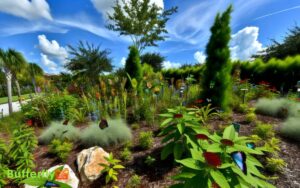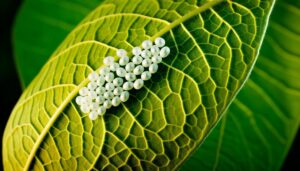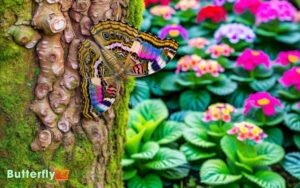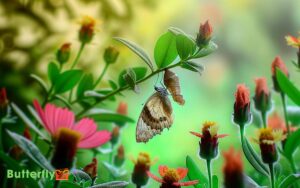7 Native Plants to Use Instead of Butterfly Bush
Opt for native plants like milkweed, Joe-Pye weed, asters, coneflowers, blazing star, and bee balm instead of butterfly bush to support local ecosystems and pollinator populations. Milkweed hosts monarch butterflies and deters predators with its cardiac glycosides.
Joe-Pye weed and bee balm attract diverse pollinators with their beautiful, nectar-rich flowers. Asters and coneflowers provide late-season food, while blazing star offers striking flower spikes and drought tolerance.
These plants thrive in various soil types, enhance biodiversity, and require minimal maintenance. Engage with these choices to greatly impact garden ecosystems and discover deeper benefits.
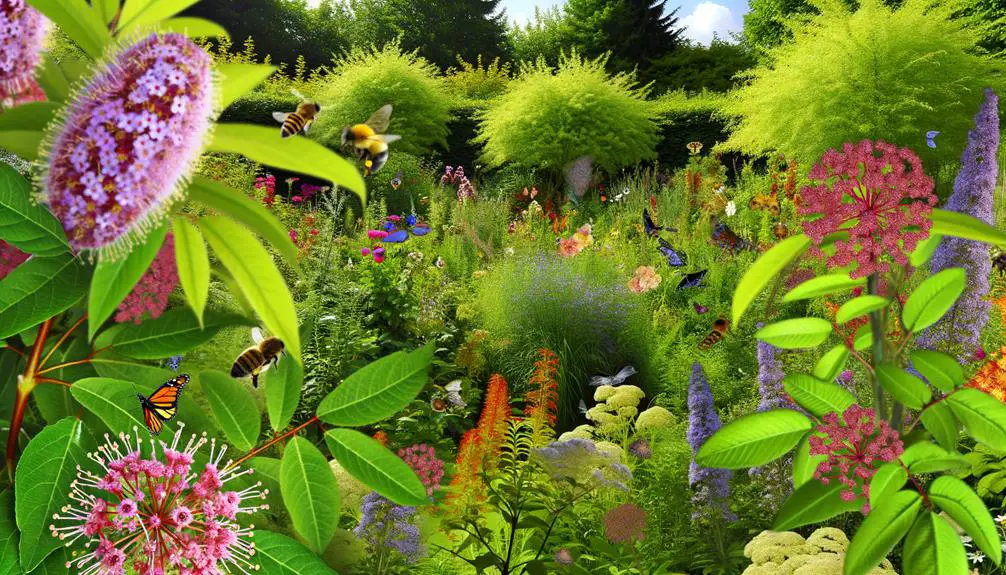
Key Takeaways
- Milkweed supports monarch butterflies and diverse pollinators while thriving in various soil types.
- Joe-Pye Weed attracts numerous pollinators and improves soil structure with its deep roots.
- Asters provide late-season nectar and habitats for beneficial insects, enhancing biodiversity.
- Coneflowers attract a variety of pollinators, are drought-tolerant, and require minimal maintenance.
Milkweed
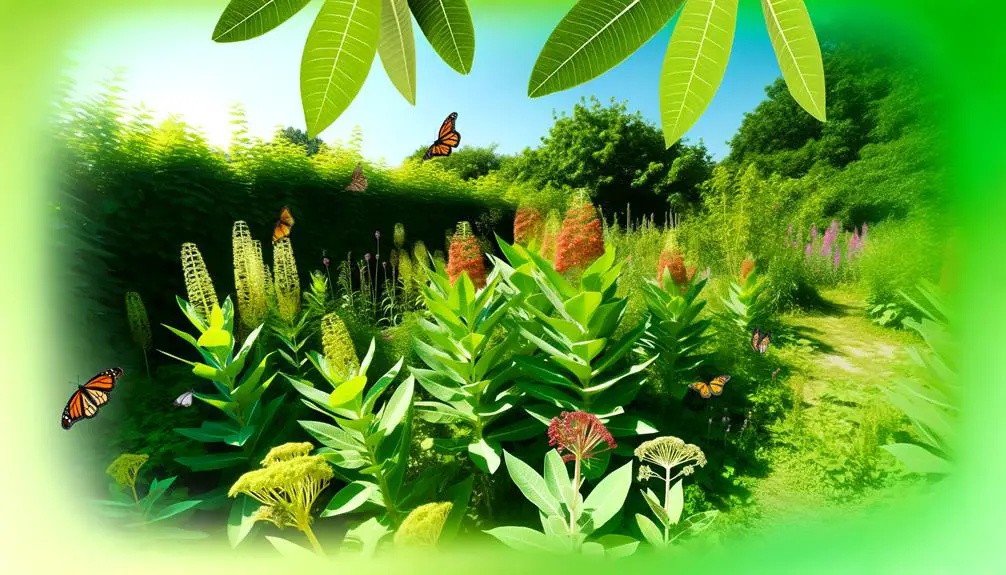
Milkweed (Asclepias spp.) serves as an essential host plant for monarch butterflies, providing both nectar for adults and foliage for caterpillars. This genus comprises over 100 species, each contributing uniquely to the ecosystem.
The plants contain cardiac glycosides, toxic compounds that caterpillars ingest, rendering them unpalatable to predators. Milkweed flowers exhibit complex morphology, featuring a corona and hood, which aids in effective pollination by insects.
Additionally, they play a pivotal role in supporting diverse pollinators beyond monarchs, including bees and other butterflies. Planting milkweed not only aids in monarch conservation but also enhances local biodiversity.
It thrives in various soil types and conditions, making it a versatile choice for gardeners aiming to support ecological health.
Joe-Pye Weed
Another excellent alternative to the butterfly bush is Joe-Pye Weed (Eutrochium spp.), a robust perennial known for its towering height and clusters of mauve-pink flowers that attract a myriad of pollinators, including butterflies and bees.
Native to North America, Joe-Pye Weed thrives in moist, well-drained soils and can reach heights of up to 7 feet, making it a striking addition to any garden. Its blooms, which appear from mid-summer to early fall, are not only visually appealing but also serve as critical nectar sources for pollinators.
In addition, its deep root system helps improve soil structure and prevent erosion. Joe-Pye Weed is particularly suited for naturalized landscapes, rain gardens, and pollinator-friendly habitats.
Asters
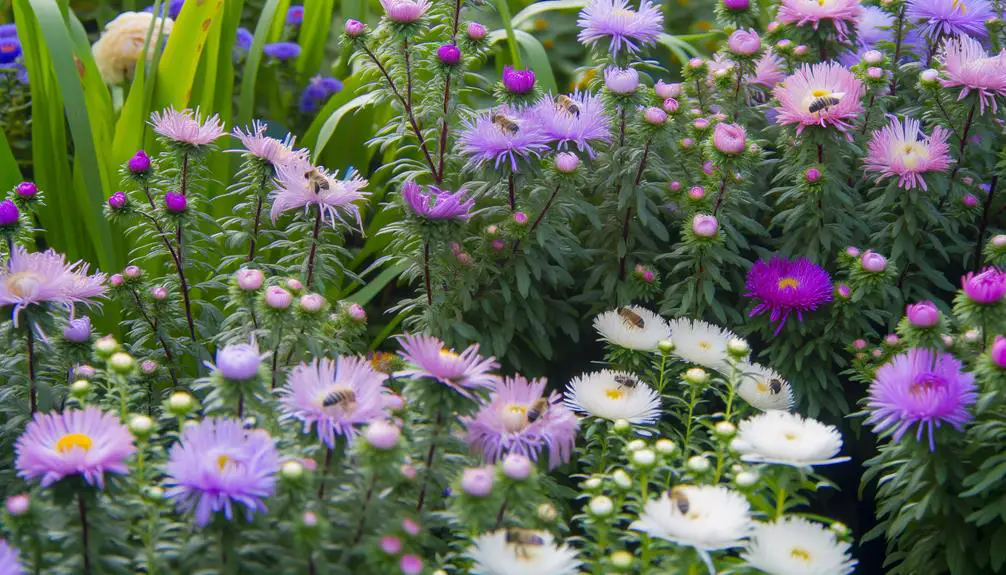
Asters (Symphyotrichum spp.), with their vibrant, star-shaped flowers, offer a scientifically robust alternative to butterfly bush, providing essential late-season nectar for pollinators.
These perennials are particularly valuable for their role in supporting a diverse array of insect species, including bees, butterflies, and moths.
Asters thrive in a range of soil types and exhibit remarkable adaptability to different environmental conditions, making them a versatile choice for various landscapes.
Their extensive blooming period, typically from late summer to fall, guarantees a continuous food source for pollinators when other floral resources are scarce.
Additionally, asters contribute to biodiversity by establishing habitats that support beneficial insects and other wildlife, thereby fostering a balanced and resilient ecosystem.
Coneflowers
Coneflowers (Echinacea spp.) are exceptional alternatives to butterfly bush, offering robust benefits for both pollinator attraction and garden maintenance.
Their vibrant, daisy-like blooms are highly effective in drawing in a variety of pollinators, including bees and butterflies, thereby enhancing biodiversity.
Additionally, coneflowers are renowned for their low maintenance requirements, thriving in a range of soil conditions and exhibiting significant drought tolerance.
Attracting Pollinators Naturally
Native to North America, Echinacea species, commonly known as coneflowers, are highly effective at attracting a diverse range of pollinators due to their vibrant colors and rich nectar sources. These robust perennials are particularly favored by bees, butterflies, and hummingbirds. The combination of their prominent flower heads and extended blooming period makes them an essential component of pollinator gardens.
| Pollinator | Attraction Mechanism | Peak Interaction Period |
|---|---|---|
| Bees | Bright colors | Summer |
| Butterflies | Nectar-rich flowers | Mid to late summer |
| Hummingbirds | Tubular petals | Early to mid summer |
| Moths | Nighttime blooming | Late summer to fall |
| Beetles | Pollen availability | Spring to summer |
This diversity in pollinator attraction not only supports ecological balance but also enhances the aesthetic and biological value of the garden.
Low Maintenance Benefits
Due to their inherent resilience and adaptability, coneflowers (Echinacea species) require minimal maintenance, making them an ideal choice for both novice and seasoned gardeners.
These perennials thrive in a variety of soil types, including poor and well-drained soils, and are highly drought-tolerant once established. Their deep taproot system allows them to access water and nutrients efficiently, reducing the need for frequent watering and fertilization.
Additionally, coneflowers exhibit significant resistance to pests and diseases, which minimizes the necessity for chemical interventions. Their robust nature guarantees that they remain vibrant and healthy with minimal intervention, providing a sustainable and aesthetically pleasing addition to any garden landscape.
Consequently, coneflowers offer a low-maintenance yet rewarding gardening experience.
Blazing Star
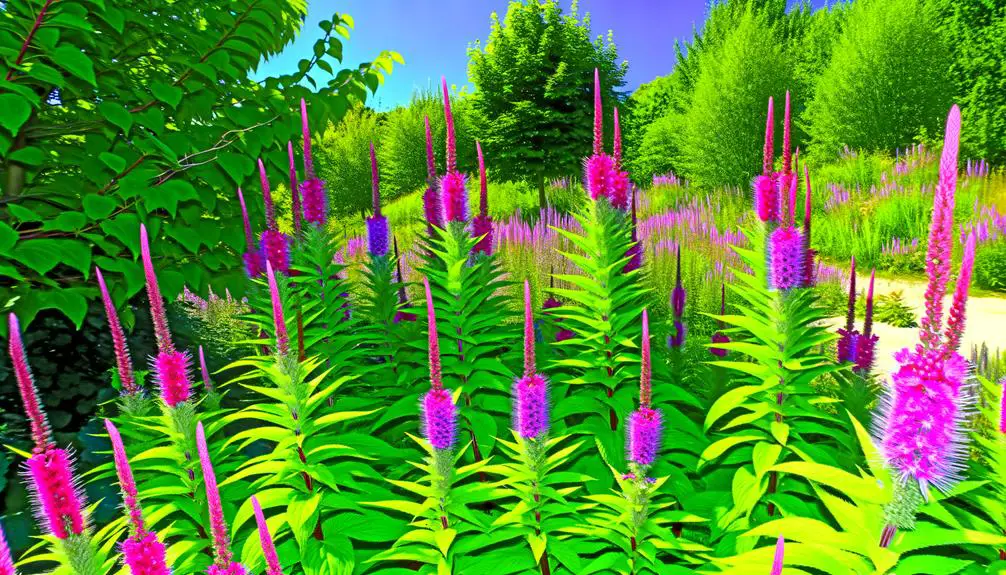
Blazing Star (Liatris spicata) serves as an excellent alternative to the Butterfly Bush, primarily due to its natural proficiency in attracting pollinators such as bees and butterflies.
This perennial plant is characterized by its low maintenance requirements, thriving in a variety of soil conditions and demonstrating substantial drought tolerance.
Additionally, Blazing Star's striking, tall flower spikes make it a versatile choice for various garden settings, from border plantings to meadow-style landscapes.
Attracts Pollinators Naturally
Among the various flora that attract pollinators, the Liatris genus, commonly known as Blazing Star, stands out for its unique ability to provide a rich nectar source for bees, butterflies, and other beneficial insects.
This perennial plant, native to North America, features tall spikes of purple, pink, or white flowers that bloom from the top down, creating a sequential flowering pattern.
The tubular florets are particularly appealing to long-tongued pollinators, facilitating efficient nectar extraction. In addition, Liatris species produce a high concentration of nectar and pollen, essential for the sustenance of pollinator populations.
The plant's robust structure supports multiple pollinator visits, thereby enhancing cross-pollination and biodiversity.
Its ecological role underscores its viability as an alternative to the invasive butterfly bush.
Easy Maintenance Requirements
Liatris, with its resilient growth habit and minimal care needs, exemplifies an ideal low-maintenance plant for gardeners seeking both aesthetic appeal and ecological benefits. This perennial, often referred to as Blazing Star, thrives in a variety of soil types, demonstrating remarkable drought tolerance once established. Its robust nature guarantees that it can withstand adverse conditions with minimal intervention. Routine maintenance primarily involves occasional watering during prolonged dry spells and removal of spent flower spikes to encourage new growth. Additionally, Liatris is seldom troubled by pests or diseases, further reducing the need for chemical treatments.
| Aspect | Requirement | Frequency |
|---|---|---|
| Watering | Moderate | Occasional |
| Soil Type | Well-drained | Consistent |
| Pruning | Deadheading required | Minimal |
| Pest Control | Rarely needed | Infrequent |
| Drought Tolerance | High | Established |
Versatile Garden Uses
Often admired for its striking vertical flower spikes, Blazing Star can be effectively utilized in a diverse array of garden settings, from formal borders to naturalistic prairie plantings.
Scientifically known as Liatris spicata, this perennial offers both aesthetic appeal and ecological benefits. In formal gardens, its rigid, upright form provides structural contrast to softer, mounding plants, enhancing visual interest.
In wildflower meadows and prairie restorations, Blazing Star supports pollinators, attracting butterflies and bees with its nectar-rich blooms. Its deep root system enhances soil structure and promotes drought resistance.
The plant's adaptability to various soil types and its tolerance to full sun make it a versatile choice, ensuring its successful integration into multiple garden designs.
Bee Balm
Known for its vibrant flowers and medicinal properties, Bee Balm (Monarda spp.) is an excellent alternative to Butterfly Bush for attracting pollinators to your garden.
Bee Balm produces tubular flowers in shades of red, pink, purple, and white, which are highly attractive to bees, butterflies, and hummingbirds. This North American native plant thrives in USDA hardiness zones 4 to 9 and prefers well-drained soil with moderate moisture.
Its aromatic foliage, rich in essential oils, serves as a natural deterrent for deer and other pests. Additionally, Bee Balm has historical uses in traditional medicine for treating ailments such as colds and digestive issues.
Its robust growth and ecological benefits make it a valuable addition to any pollinator-friendly landscape.
Conclusion
In light of ecological considerations, planting native species such as Milkweed, Joe-Pye Weed, Asters, Coneflowers, Blazing Star, and Bee Balm provides a more sustainable alternative to butterfly bush. These native plants not only support local pollinators but also contribute to a healthier and more balanced ecosystem. Unlike non-native species, they require less maintenance and are naturally adapted to local soil and climate conditions. Incorporating these butterfly bush companion plants into gardens can enhance biodiversity while providing essential food and habitat for butterflies and other beneficial insects.
These native plants serve as veritable lifelines for pollinators, enhancing biodiversity and ecosystem health.
Just as a keystone supports an arch, native flora underpin the intricate web of local ecosystems.
Prioritizing these plants fosters resilience and ecological balance, ensuring long-term environmental benefits.


